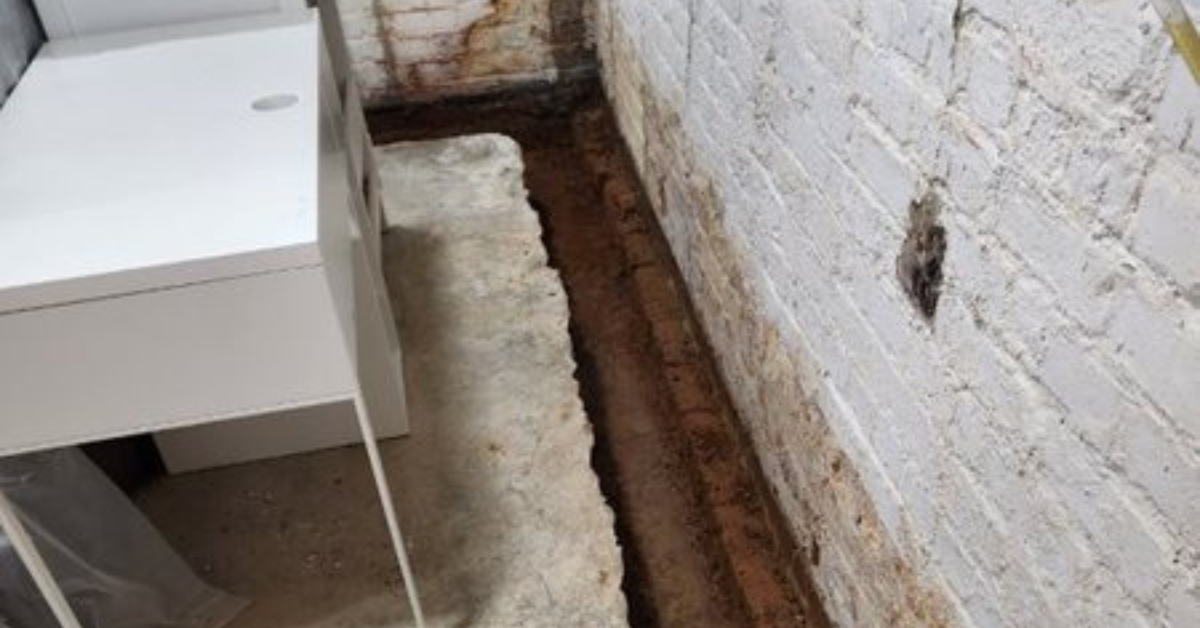
If water has been infiltrating your basement walls, it’s important to address the issue promptly to prevent further damage. Following some essential steps and taking proactive measures in basement waterproofing can effectively safeguard your basement from unwanted water seepage. From identifying the root cause of the leak to implementing long-term solutions, there are practical strategies you can employ to combat this common household problem. Stay tuned to discover how a few simple changes can significantly protect your basement environment.
Key Takeaways
- Fill cracks with waterproof sealant to prevent water infiltration.
- Install exterior drainage systems to redirect water away from the foundation.
- Monitor for leaks regularly and seal visible cracks promptly.
- Consider professional waterproofing for thorough and lasting solutions.
- Improve grading and landscaping to promote better water drainage.
Identify the Source of the Leak
To pinpoint the source of a leak in your basement walls, conduct a thorough visual inspection for any visible cracks or areas of moisture penetration. Begin with an exterior inspection to identify any signs of water entry points. Look for cracks, gaps, or deteriorated areas in the walls that could be allowing water infiltration. Pay close attention to areas where the ground meets the foundation, as these are common areas for water to seep in. Additionally, check for any issues with the grading around your home that may be directing water toward the foundation. A proper drainage evaluation is vital to understanding how water moves around your property.
Next, move on to a detailed waterproofing assessment of the exterior of your basement walls. Look for any areas where the waterproofing membrane may be compromised or damaged. This could include cracks in the foundation, gaps around pipes or windows, or deteriorated sealant. These vulnerable spots can be prime locations for water to find its way into your basement. By conducting a meticulous inspection, you can effectively detect the source of the leak and take the necessary steps to address it, ensuring a dry and secure basement environment for your home.
Repair Cracks in the Wall
To effectively address wall cracks in your basement, start by filling them with a suitable material that can withstand moisture and pressure. Then, utilize a high-quality waterproof sealant to ensure a tight seal and prevent future water intrusion. Regularly monitor the repaired cracks for any signs of leaks to catch and address issues promptly.
Fill Wall Cracks
Consider applying a waterproof sealant to fill and repair any cracks in your basement walls. When it comes to fixing wall cracks, here are some essential tips to guarantee a successful repair:
- Preparation is Key: Clean the crack thoroughly before filling to ensure better adhesion.
- Choose the Right Sealant: Select a high-quality waterproof sealant designed for basement walls.
- Follow Manufacturer Instructions: Adhere to the application guidelines provided by the sealant manufacturer.
- Monitor and Maintain: Regularly inspect the sealed cracks for any signs of re-emergence and reapply a sealant if needed.
Use Waterproof Sealant
Repairing cracks in your basement walls with a high-quality waterproof sealant is essential to preventing water infiltration. Regarding waterproofing techniques, using a waterproof sealant is a cost-effective and efficient way to address cracks and gaps in your basement walls. High-quality sealants can seal off any openings, allowing water to seep through.
While some homeowners opt for a do-it-yourself approach to waterproofing, it’s noteworthy that professional waterproofing services often provide more thorough solutions. Professionals have the expertise and tools to identify underlying issues causing water intrusion and can recommend the most effective waterproofing methods.
Whether you choose a DIY approach or hire a professional contractor, using a waterproof sealant is a vital step in keeping your basement dry and protected.
Monitor for Leaks
Inspect cracks in your basement walls regularly to identify and repair any leaks. Small cracks can allow water to seep into your basement, leading to potential damage over time. To effectively monitor for leaks and prevent water from coming through your basement wall, follow these steps:
- Use a flashlight to check for cracks or gaps in the walls.
- Look for any signs of water stains or mold growth, indicating water entry points.
- Seal any visible cracks with a waterproof sealant to prevent further leakage.
- Consider applying a waterproof coating to the interior or exterior of the basement walls for added protection against moisture infiltration.
Regular maintenance and proactive leak detection can help safeguard your basement from water damage.

Install Exterior Drainage Systems
When installing exterior drainage systems, begin by digging trenches for drains along the perimeter of your basement.
Guarantee the trenches slope away from the foundation to direct water flow.
Waterproof the walls with a suitable membrane to prevent water infiltration.
Digging for Drains
Consider excavating the perimeter of your home to install exterior drainage systems as a proactive measure against basement wall water infiltration. This process involves meticulous planning and execution to ensure the effectiveness of the drainage system.
Here are some essential steps to guide you through the drainage excavation:
- Survey the Area: Identify the areas around your home where water accumulation is most significant.
- Plan the Excavation: Develop a detailed plan outlining the depth and layout of the drainage system.
- Excavate Carefully: Use proper equipment to dig trenches along the perimeter, ensuring the correct slope for water flow.
- Soil Compaction: After installing the drainage system, compact the soil properly to prevent future settling issues.
Waterproofing the Wall
To effectively waterproof the basement wall, installing exterior drainage systems is essential for preventing water infiltration and potential structural damage. Exterior waterproofing methods involve excavating around the perimeter of the foundation to apply a waterproof barrier. This barrier shields the basement wall from moisture, directing water away from the foundation.
Additionally, during this process, it’s advantageous to contemplate basement wall insulation. Insulating the basement wall can help regulate temperature, reduce condensation, and enhance the overall energy efficiency of your home.
Improve Grading and Landscaping
Enhancing grading and landscaping around your basement walls can greatly reduce the risk of water infiltration. Properly managing the water flow around your home is vital to keep your basement dry. Here are some key steps to improve grading and landscaping:
- Soil Compaction: Ensure that the soil around your basement walls is compacted properly. Loose soil can lead to water pooling and seeping into your basement. Use a soil compactor to achieve the right level of compaction.
- Drainage: Install a proper drainage system, such as French drains, to redirect water away from your basement walls. Ensure the drains are sloped away from the foundation to prevent water from accumulating near the walls.
- Landscaping: Consider adjusting the landscaping around your home to promote better water drainage. Plant vegetation that can absorb excess water and prevent runoff towards the basement walls.
- Slope Adjustment: Check the slope of the ground around your home. Ensure the land slopes away from the foundation to prevent water from flowing towards your basement. Adjust the slope if necessary to improve water runoff.
Implementing these grading and landscaping improvements can significantly decrease the chances of water penetrating your basement walls. Taking proactive measures to manage water flow around your home is essential in maintaining a dry and secure basement.
Seal Basement Walls With Waterproofing
To effectively waterproof your basement walls, start by thoroughly inspecting the foundation for any cracks or vulnerabilities that may allow water infiltration. If you notice any openings, it’s important to address them promptly to prevent water from seeping into your basement. When it comes to sealing basement walls with waterproofing, you have two main options: hiring basement waterproofing contractors or using DIY waterproofing methods.
Basement waterproofing contractors are professionals experienced in identifying and addressing basement waterproofing issues. They’ve got the expertise and tools to provide thorough solutions customized to your specific needs. By engaging basement waterproofing contractors, you can ensure that the job is done effectively and efficiently, giving you peace of mind knowing that your basement walls are adequately protected against water damage.
On the other hand, if you prefer a more hands-on approach, DIY waterproofing methods can also be effective in sealing basement walls. These methods typically involve using waterproofing products such as sealants, waterproofing paints, or membranes that you can apply yourself. While DIY waterproofing may require more time and effort on your part, it can be a cost-effective solution for those looking to tackle the project independently.
Whether you choose to enlist the help of basement waterproofing contractors or opt for a DIY approach, making sure that your basement walls are properly sealed is essential in preventing water infiltration and keeping your basement dry.
Use Interior Drainage Solutions
Consider installing interior drainage solutions as a proactive measure to manage water seepage in your basement effectively. When dealing with basement waterproofing, interior drainage solutions play an essential role in directing water away from your home’s foundation.
Here are four key strategies to help you combat water seepage through your basement walls:
- French Drain System: A French drain consists of a perforated pipe installed beneath the basement floor to collect and redirect water to a sump pump for removal. This system helps alleviate hydrostatic pressure and prevents water from entering your basement.
- Sump Pump Installation: A sump pump is a crucial component of any interior drainage system. It collects water from the French drain or other drainage channels and pumps it away from your home, keeping your basement dry.
- Interior Waterproofing Membrane: Applying a waterproofing membrane on the interior walls of your basement creates a barrier that prevents water penetration. This membrane acts as an additional line of defense against moisture intrusion.
- Interior Drainage Channel: Installing an interior drainage channel along the perimeter of your basement floor can effectively capture and redirect water to the sump pump, ensuring proper drainage and minimizing the risk of water damage.
Consider Professional Waterproofing Assistance
If you’re facing persistent water seepage issues despite interior drainage solutions, seeking professional waterproofing assistance can provide specialized expertise for a more thorough solution. A waterproofing consultation with experienced professionals can offer a detailed assessment of your basement’s waterproofing needs. These experts can determine the root cause of the water infiltration and recommend customized solutions to effectively address the issue.
Professional waterproofing solutions often involve advanced techniques and high-quality materials that may not be readily available to the average homeowner. Waterproofing specialists have the knowledge and tools to seal cracks, reinforce foundations, and install effective drainage systems that can greatly reduce or eliminate water seepage in your basement.
During a waterproofing consultation, professionals will conduct a comprehensive inspection of your basement to identify weak points in the structure that could be contributing to water intrusion. They’ll then propose a detailed plan of action that may include exterior waterproofing, interior sealants, or the installation of sump pumps to keep your basement dry.
Investing in professional waterproofing assistance can provide long-term benefits by protecting your home from water damage, mold growth, and structural issues caused by moisture. By entrusting your waterproofing needs to experts in the field, you can ensure a durable and effective solution that enhances your home’s overall safety and comfort.
Review
By pinpointing the source of the leak, fixing cracks with waterproof sealant, installing exterior drainage systems, improving grading, and sealing walls with waterproofing, you can effectively prevent water from seeping into your basement.
Remember, thorough prevention is crucial to safeguard your property from potential damage.
Consult with professionals for holistic solutions and protect your basement from water issues.
At Tiger C Construction, we are dedicated professionals in basement waterproofing, offering reliable and expert services throughout Petersburg, Hopewell, and Midlothian.
